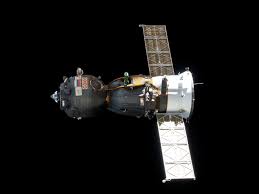Soyuz Spacecraft:

A Soyuz spacecraft carrying two Russians and an American docked at the International Space Station (ISS) recently, a little more than three hours after its launch.
- The Soyuz (saw-yooz) is a Russian spacecraft.
- The Soyuz programme is the longest operational human spacecraft programme in the history of space exploration.
- Russian crew members are called cosmonauts. NASA crew members from the United States are called astronauts. Crew members from Europe, Canada, and Japan are also called astronauts.
- The Soyuz takes cosmonauts and astronauts to and from the ISS.
- The Soyuz spacecraft weighs 7 tonnes; they measure 7.2 m in length and 2.7 m in diameter. A Soyuz has room for three people to ride in it.
- The spacecraft also brings food, water, and other essential supplies to the ISS.
- The Soyuz serves a dual purpose, acting as a transportation vehicle and a safety measure.
- At least one Soyuz remains docked to the space station at all times, ready to serve as an emergency escape pod should the need arise, allowing the crew to quickly evacuate and return to Earth.
- The Soyuz spacecraft consists of three distinct modules, each serving a specific purpose.
- The Orbital Module, comparable in size to a large van, provides living quarters for the crew during their time in orbit and can connect directly to the space station.
- The Descent Module, as its name suggests, is utilized by the crew during the launch phase and the return journey to Earth.
- It is specifically designed to withstand the rigors of re-entry and ensure a safe landing.
- The third module houses the spacecraft’s critical life support systems, including batteries, solar panels, and steering engines, all of which are essential for the Soyuz’s operation and the crew’s well-being.
- The Soyuz capsule is propelled into space by a Soyuz rocket, with the two components separating once the spacecraft reaches orbit.
- While the rocket returns to Earth, the capsule continues its journey, remarkably reaching space in a mere nine minutes.




